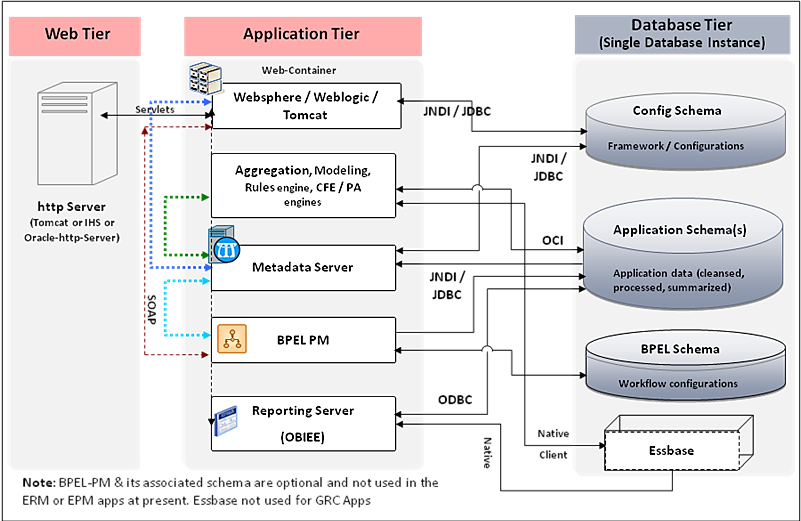Components of OFSAAI
An overview of the technological components of the OFSAA Infrastructure.
The OFSAA Infrastructure consists of the following components/modules that are used to deploy an analytical solution.
- Data Model Management is intended for uploading the warehouse data from the operational systems to database schema using erwin XML file.
- Data Management Framework is a comprehensive data integration platform that facilitates all the data integration requirements from high-volume and high-performance batch loads to event-driven integration processes and SOA-enabled data services. This module is used for managing Data movement. This includes sub modules like Data Sources, Data Mapping, Post Load Changes and Data Quality Framework.
- Data Entry Forms and Queries module facilitates you to design web-based user friendly Data Entry windows with a choice of layouts for easy data view and data manipulation. This module has sub modules like Forms Designer, Data Entry, and Excel Upload.
- Data Maintenance Interface module helps in the design and creation of forms that are in a user-specified format. Authorized users with the required privileges can use these forms to view and update existing data in the database.
- Unified Analytical Metadata is intended for the Information and Business Analysts who are instrumental in supporting and affecting analytical decisions. This module is used to define and maintain analytical metadata definitions. This module has sub modules like Alias, Derived Entity, Dataset, Dimension Management, Business Measure, Business Processor, Build Hierarchy, Business Dimension, Essbase Cube, Filters, Expression, Map Maintenance, and Cube Migration.
- Rule Run Framework facilitates you to define a set of rules, reporting objects, and processes that are required to transform data in a warehouse. This module has sub modules like Rule, Process, Run, and Manage Run Execution.
- Metadata Browser module provides extensive browsing capabilities of metadata, helps in tracking the impact of changes to metadata, and trace through to the source of originating data. The metadata in the Metadata Browser window is organized into different categories like Data Foundation Metadata, Business Metadata, and Process Metadata.
- Operations module facilitates you in administration and processing of business data to create the highest level of efficiency within the system and to derive results based on a specified rule. It includes sections like Batch Maintenance, Batch Execution, Batch Scheduler, Batch Monitor, Batch Processing Report, Batch Cancellation, and View Log.
- Questionnaire module is an assessment tool, which presents a set of questions to users, and collects the answers for analysis and conclusion. It can be interfaced or plugged into OFSAA application packs.
- System Configuration & Identity Management module facilitates System Administrators to provide security and operational framework required for Infrastructure. Administration window has a Tiles menu with Tiles like System Configuration, Identity Management, Database Details, Manage OFSAA Product Licenses, Create New Application, Information Domain, Translation Tools and Process Modelling Framework.
- Object Administration facilitates System Administrators
to define the security framework with the capacity to restrict access to the
data and metadata in the warehouse, based on a flexible, fine-grained access
control mechanism. These activities are mainly done at the initial stage and
then on a need basis. It includes sections like Object Security, Object
Migration, and Utilities (consisting of Metadata Difference, Metadata
Authorization, Save Metadata, Write-Protected Batch, Component Registration,
Transfer Document Ownership, and Patch Information).
Note:
For information about OFSAA Product Licenses after installation of Application Packs, see the View OFSAA Product Licenses After Installation of Application Pack section.
All components are encapsulated within a common Security and Operational Framework as shown in the following figure:
Figure 3-1 Security and Operational Framework

Infrastructure also supports many business analytical solution(s) like Operational Risk, PFT, and Basel, which are licensed separately to the organization. This manual provides an overview of only the technological components.